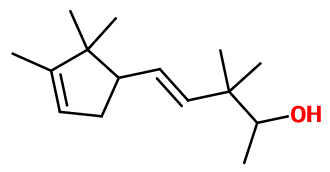
Photo credits: ScenTree SAS
| Company | Ingredient Name | ID | Comments | Naturality | Certifications | Purity | Latin name | Treated part | Geographical origin | MOQ |
|---|---|---|---|---|---|---|---|---|---|---|
|
|
Polysantol® - 30gr | - |
Visit website
|
- | - | - | - | - | - |
General Presentation
-
CAS N° : 107898-54-4
-
EINECS number : 411-580-3
-
FEMA number : Donnée indisponible.
-
FLAVIS number : Donnée indisponible.
-
JECFA number : Donnée indisponible.
-
Appearance : Colorless liquid
-
Density : 0,902
-
Volatility : Base
-
Price Range : €€
Physico-chemical properties
-
Molecular formula : C15H26O
-
Molecular Weight : 222,37 g/mol
-
Log P : 4,7
-
Fusion Point : Donnée indisponible.
-
Boiling Point :
-
Detection Threshold : Donnée indisponible.
-
Optical rotation : Donnée indisponible
-
Vapor pressure : Donnée indisponible
-
Refractive Index @20°C : Donnée indisponible
-
Acid Value : Donnée indisponible.
-
Flash Point : >100°C (>212°F)
Uses
Uses in perfumery :
Polysantol® is used in woody accords, linked with musky notes, in milk accords and in sandalwood notes in woody perfumes. Brings a cosmetic note.
Year of discovery :
1984 'Polysantol®' trademark has been published and protected by Firmenich SA since 22/10/1985 (brand N°497404)
Natural availability :
Polysantol® is not available in its natural state.
Isomerism :
Polysantol® has a double bond and two asymmetric carbons that give rise to several isomers of this molecule. It is nevertheless its mixture of isomers that is used in perfumery. In addition, Polysantol® is a constitutional isomer of Javanol®. These two compounds have a similar structure, and are used for similar reasons in perfumery. Javanol® has a less milky note than Polysantol®, but is more powerful.
Synthesis precursor :
Polysantol® is not used to synthesize other compounds of organoleptic interest.
Synthesis route :
Polysantol® is synthesized from campholenaldehyde, condensed with butan-2-one in an acid medium to give 3-methyl-5-(2,2,3-trimethyl-3-cyclopenten-1-yl)-3-penten-2-one as an intermediate product. A methylation step under phase transfer conditions provides a new product, which can be reduced by sodium borohydride to get Polysantol®.
Regulations & IFRA
Allergens :
This ingredient does not contain any allergen.
IFRA 51th :
This ingredient is restricted by the 51th amendment
- Quantitative limit on the use :
-
Cat.1 Cat.2 Cat.3 Cat.4 Cat.5A B C DCat.6 0,031 % 0,057 % 0,25 % 1,1 % 0,27 % 0,27 % 0,27 % 0,091 %0,031 % Cat.5A B C DCat.6 0,27 % 0,27 % 0,27 % 0,091 %0,031 % Cat.7A BCat.8 Cat.9 Cat.10A BCat.11A BCat.12 0,63 % 0,63 %0,091 % 1,7 % 1,7 % 4 %0,091 % 0,091 %No Restriction Cat.10A BCat.11A BCat.12 1,7 % 4 %0,091 % 0,091 %No Restriction



